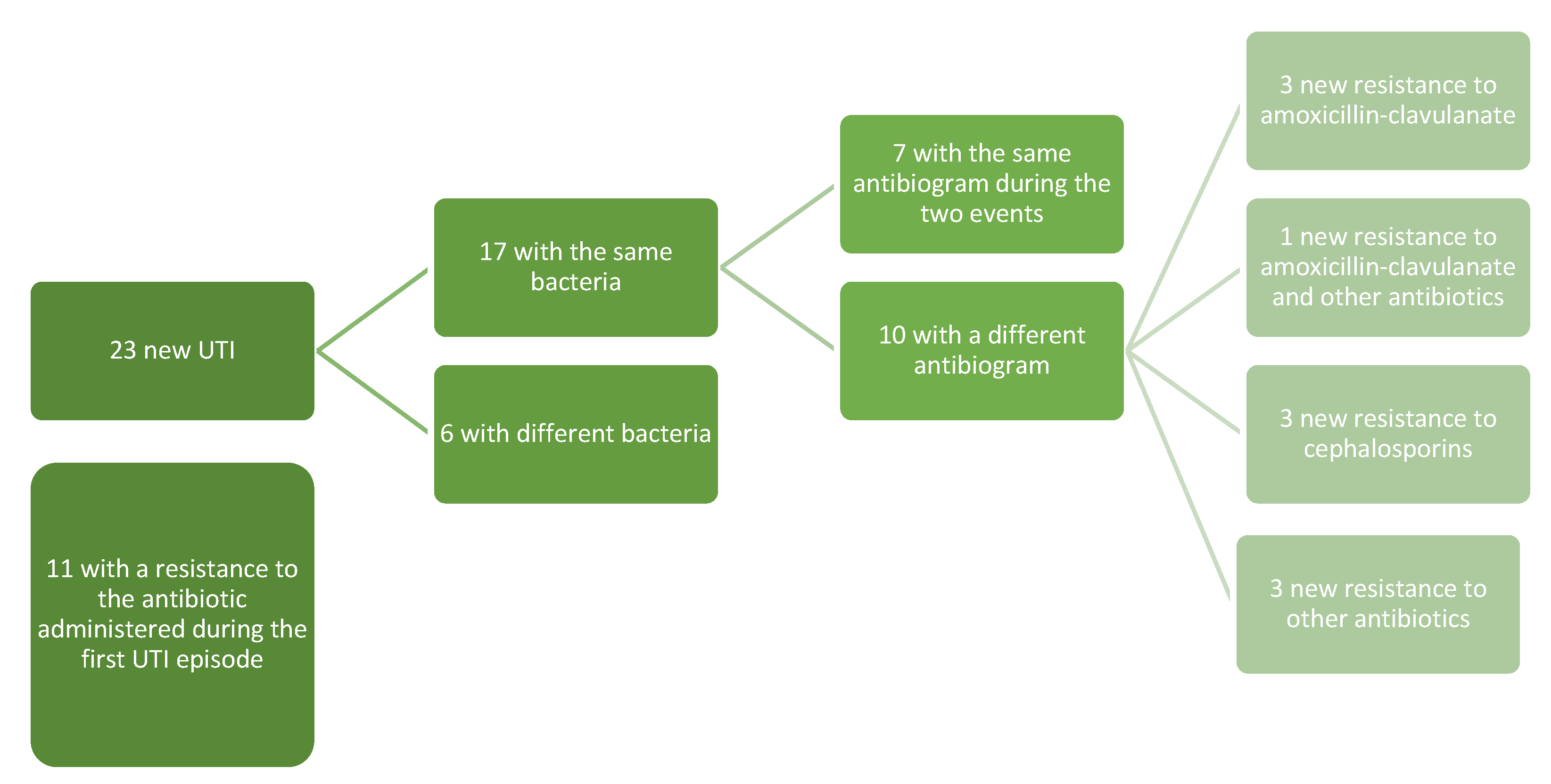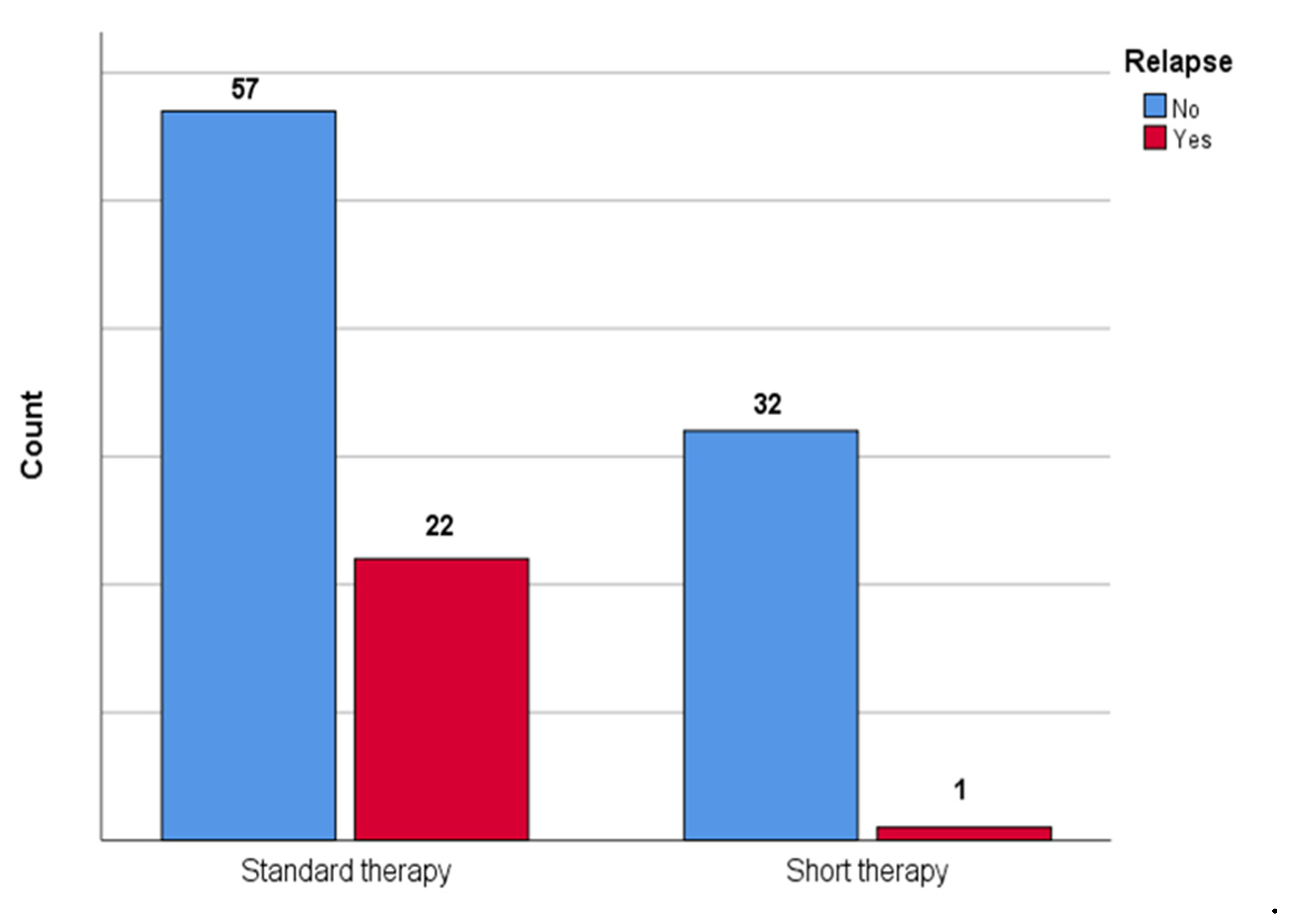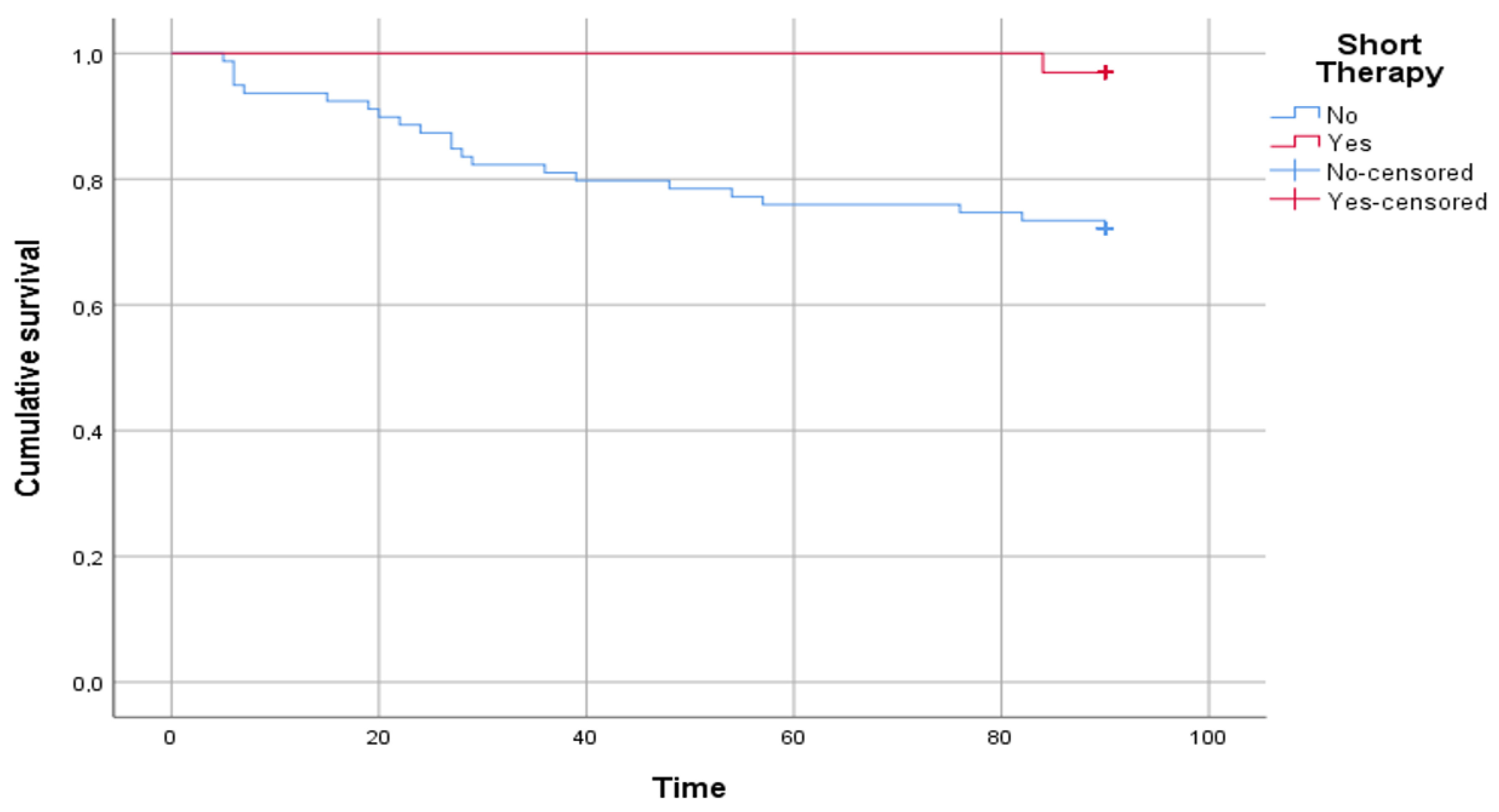Comparison between Short Therapy and Standard Therapy in Pediatric Patients Hospitalized with Urinary Tract Infection: A Single Center Retrospective Analysis
Abstract
1. Introduction
2. Methods
2.1. Inclusion Criteria
- -
- Age > 60 days.
- -
- Clinical diagnosis of febrile UTI defined by a fever of ≥38 °C AND:
- -
- A positive result of urinalysis (nitrite and/or leukocyte esterase positivity) in one urine sample collected by bladder catheterization or clean-voided urine AND positive urine culture for a single type of bacterium with a charge of >104 CFU/mL (or, in the case of more than one germ isolated with at least one of them having a charge of >104 CFU/mL).
- -
- Positive urine culture for a single type of bacterium with a charge of >104 CFU/mL, even in the case of normal urinalysis if the child had compatible signs and symptoms and blood laboratory findings AND no other alternative diagnoses were obtained AND the treating clinicians considered the case and treated as a UTI AND the child was discharged with only the diagnosis of a UTI.
- -
- A clinical diagnosis of afebrile UTI defined by compatible signs and symptoms (e.g., difficulty → feeding, vomiting, irritability) AND:
- Admitted because of UTI.
- No urinary tract abnormalities.
- Negative blood cultures.
2.2. Exclusion Criteria
- -
- Antibiotic administration in the 3 days prior to admission.
- -
- Age > 18 years.
- -
- Immune deficiencies.
- -
- At least one of the following urinary tract abnormalities:
- Unilateral or bilateral renal hypoplasia.
- Pelvi-caliceal dilatation (2° SFU grade hydronephrosis).
- Ureteral dilatation.
- Bladder abnormalities (ureterocele, diverticulum).
3. Outcomes
- To evaluate the impact of clinical, demographic and microbiological characteristics on UTI relapse in the two groups of children treated with a short or long course of antibiotic therapy.
- To evaluate the impact of a short or long course of antibiotic therapy on a relapse with a similar bacteria or a bug resistant to the originally used antibiotic.
- To evaluate relapse rates over time during a 90-day period of follow-up.
- A comparison between the characteristics of relapse patients and non-relapse patients.
4. Statistical Analysis
Ethic Committee
5. Results
5.1. Study Population
5.2. Duration of Antibiotic Therapy and Outcomes
6. Discussion
Author Contributions
Funding
Institutional Review Board Statement
Informed Consent Statement
Data Availability Statement
Conflicts of Interest
References
- Hoberman, A.; Chao, H.P.; Keller, D.M.; Hickey, R.; Davis, H.W.; Ellis, D. Prevalence of urinary tract infection in febrile infants. J. Pediatr. 1993, 123, 17–23. [Google Scholar] [CrossRef]
- Urinary Tract Infections in Children. Linee Guida SIU UTI 2015. Available online: https://siu.it/linee-guida/raccomandazioni-siu/2015-raccomandazioni-siu/raccomandazioni-in-tema-di-infezioni-delle-vie-urinarie (accessed on 16 September 2022).
- Subcommittee on Urinary Tract Infection; Steering Committee on Quality Improvement and Management; Roberts, K.B. Urinary tract infection: Clinical practice guideline for the diagnosis and management of the initial UTI in febrile infants and children 2 to 24 months. Pediatrics 2011, 128, 595–610. [Google Scholar] [CrossRef] [PubMed]
- Yahav, D.; Franceschini, E.; Koppel, F.; Turjeman, A.; Babich, T.; Bitterman, R.; Neuberger, A.; Ghanem-Zoubi, N.; Santoro, A.; Eliakim-Raz, N.; et al. Bacteremia Duration Study Group. Seven Versus 14 Days of Antibiotic Therapy for Uncomplicated Gram-negative Bacteremia: A Noninferiority Randomized Controlled Trial. Clin. Infect. Dis. 2019, 69, 1091–1098. [Google Scholar] [CrossRef] [PubMed]
- Chotiprasitsakul, D.; Han, J.H.; Cosgrove, S.E.; Harris, A.D.; Lautenbach, E.; Conley, A.T.; Tolomeo, P.; Wise, J.; Tamma, P.D. Antibacterial Resistance Leadership Group. Comparing the Outcomes of Adults with Enterobacteriaceae Bacteremia Receiving Short-Course Versus Prolonged-Course Antibiotic Therapy in a Multicenter, Propensity Score-Matched Cohort. Clin. Infect. Dis. 2018, 66, 172–177. [Google Scholar] [CrossRef]
- Bell, B.G.; Schellevis, F.; Stobberingh, E.; Goossens, H.; Pringle, M. A systematic review and meta-analysis of the effects of antibiotic consumption on antibiotic resistance. BMC Infect. Dis. 2014, 14, 13. [Google Scholar] [CrossRef]
- Fuchs, B.B.; Tharmalingam, N.; Mylonakis, E. Vulnerability of long-term care facility residents to Clostridium difficile infection due to microbiome disruptions. Future Microbiol. 2018, 13, 1537–1547. [Google Scholar] [CrossRef]
- Brodin, P. Immune-microbe interactions early in life: A determinant of health and disease long term. Science 2022, 376, 945–950. [Google Scholar] [CrossRef]
- Fox, M.T.; Amoah, J.; Hsu, A.J.; Herzke, C.A.; Gerber, J.S.; Tamma, P.D. Comparative Effectiveness of Antibiotic Treatment Duration in Children with Pyelonephritis. JAMA Netw. Open. 2020, 3, e203951. [Google Scholar] [CrossRef]
- Wingler, M.J.B.; Tamma, P.D. Defining effective durations of antibiotic therapy for community-acquired pneumonia and urinary tract infections in hospitalized children. Curr. Opin. Infect. Dis. 2022, 35, 442–451. [Google Scholar] [CrossRef]
- Duong, Q.A.; Pittet, L.F.; Curtis, N.; Zimmermann, P. Antibiotic exposure and adverse long-term health outcomes in children: A systematic review and meta-analysis. J. Infect. 2022, 85, 213–300. [Google Scholar] [CrossRef]
- A’t Hoen, L.; Bogaert, G.; Radmayr, C.; Dogan, H.S.; Nijman, R.J.M.; Quaedackers, J.; Rawashdeh, Y.F.; Silay, M.S.; Tekgul, S.; Bhatt, N.R.; et al. Update of the EAU/ESPU guidelines on urinary tract infections in children. J. Pediatr. Urol. 2021, 17, 200–207, Erratum in: J. Pediatr. Urol. 2021, 17, 598. [Google Scholar] [CrossRef] [PubMed]
- Okarska-Napierała, M.; Wasilewska, A.; Kuchar, E. Urinary tract infection in children: Diagnosis, treatment, imaging—Comparison of current guidelines. J. Pediatr. Urol. 2017, 13, 567–573. [Google Scholar] [CrossRef] [PubMed]
- Tersigni, C.; Montagnani, C.; D’Argenio, P.; Duse, M.; Esposito, S.; Hsia, Y.; Sharland, M.; Galli, L. Antibiotic prescriptions in Italian hospitalised children after serial point prevalence surveys (or pointless prevalence surveys): Has anything actually changed over the years? Ital. J. Pediatr. 2019, 45, 127. [Google Scholar] [CrossRef] [PubMed]
- Mori, R.; Lakhanpaul, M.; Verrier-Jones, K. Diagnosis and management of urinary tract infection in children: Summary of NICE guidance. BMJ 2007, 335, 395–397. [Google Scholar] [CrossRef]
- Ammenti, A.; Alberici, I.; Brugnara, M.; Chimenz, R.; Guarino, S.; La Manna, A.; La Scola, C.; Maringhini, S.; Marra, G.; Materassi, M.; et al. Italian Society of Pediatric Nephrology. Updated Italian recommendations for the diagnosis, treatment and follow-up of the first febrile urinary tract infection in young children. Acta Paediatr. 2020, 109, 236–247. [Google Scholar] [CrossRef]
- Finnell, S.M.; Carroll, A.E.; Downs, S.M. Subcommittee on Urinary Tract Infection. Technical report—Diagnosis and management of an initial UTI in febrile infants and young children. Pediatrics 2011, 128, e749–e770. [Google Scholar] [CrossRef]
- Desai, S.; Aronson, P.L.; Shabanova, V.; Neuman, M.I.; Balamuth, F.; Pruitt, C.M.; DePorre, A.G.; Nigrovic, L.E.; Rooholamini, S.N.; Wang, M.E.; et al. Febrile Young Infant Research Collaborative. Parenteral Antibiotic Therapy Duration in Young Infants with Bacteremic Urinary Tract Infections. Pediatrics 2019, 144, e20183844. [Google Scholar] [CrossRef]
- Michael, M.; Hodson, E.M.; Craig, J.C.; Martin, S.; Moyer, V.A. Short versus standard duration oral antibiotic therapy for acute urinary tract infection in children. Cochrane Database Syst. Rev. 2003, CD003966. [Google Scholar] [CrossRef]
- Akagawa, Y.; Kimata, T.; Akagawa, S.; Yamaguchi, T.; Kato, S.; Yamanouchi, S.; Hashiyada, M.; Akane, A.; Kino, M.; Tsuji, S.; et al. Impact of Long-Term Low Dose Antibiotic Prophylaxis on Gut Microbiota in Children. J. Urol. 2020, 204, 1320–1325. [Google Scholar] [CrossRef]
- Morello, W.; D’Amico, F.; Serafinelli, J.; Turroni, S.; Abati, I.; Fiori, J.; Baskin, E.; Yalcinkaya, F.; Jankauskiene, A.; Pennesi, M.; et al. Low-Dose Antibiotic Prophylaxis Induces Rapid Modifications of the Gut Microbiota in Infants with Vesicoureteral Reflux. Front. Pediatr. 2021, 9, 674716. [Google Scholar] [CrossRef]
- Strasser, C.; Spindelboeck, W.; Kashofer, K.; Oswald, J.; Haid, B. Low-dose antibiotic prophylaxis has no significant impact on the stability of the intestinal microbiome in children with urogenital tract malformations under 1 year of age. J. Pediatr. Urol. 2020, 16, 456.e1–456.e7. [Google Scholar] [CrossRef] [PubMed]
- Eklundh, A.; Rhedin, S.; Ryd-Rinder, M.; Andersson, M.; Gantelius, J.; Gaudenzi, G.; Lindh, M.; Peltola, V.; Waris, M.; Nauclér, P.; et al. Etiology of Clinical Community-Acquired Pneumonia in Swedish Children Aged 1-59 Months with High Pneumococcal Vaccine Coverage-The TREND Study. Vaccines 2021, 9, 384. [Google Scholar] [CrossRef] [PubMed]
- Pernica, J.M.; Harman, S.; Kam, A.J.; Carciumaru, R.; Vanniyasingam, T.; Crawford, T.; Dalgleish, D.; Khan, S.; Slinger, R.S.; Fulford, M.; et al. Short-Course Antimicrobial Therapy for Pediatric Community-Acquired Pneumonia: The SAFER Randomized Clinical Trial. JAMA Pediatr. 2021, 175, 475–482. [Google Scholar] [CrossRef] [PubMed]
- Williams, D.J.; Creech, C.B.; Walter, E.B.; Martin, J.M.; Gerber, J.S.; Newland, J.G.; Howard, L.; Hofto, M.E.; Staat, M.A.; Oler, R.E.; et al. The DMID 14-0079 Study Team. Short- vs. Standard-Course Outpatient Antibiotic Therapy for Community-Acquired Pneumonia in Children: The SCOUT-CAP Randomized Clinical Trial. JAMA Pediatr. 2022, 176, 253–261. [Google Scholar] [CrossRef]
- Bielicki, J.A.; Stöhr, W.; Barratt, S.; Dunn, D.; Naufal, N.; Roland, D.; Sturgeon, K.; Finn, A.; Rodriguez-Ruiz, J.P.; Malhotra-Kumar, S.; et al. PERUKI, GAPRUKI, and the CAP-IT Trial Group. Effect of Amoxicillin Dose and Treatment Duration on the Need for Antibiotic Re-treatment in Children with Community-Acquired Pneumonia: The CAP-IT Randomized Clinical Trial. JAMA 2021, 326, 1713–1724, Erratum in: JAMA 2021, 326, 2208. [Google Scholar] [CrossRef]
- McCallum, G.B.; Fong, S.M.; Grimwood, K.; Nathan, A.M.; Byrnes, C.A.; Ooi, M.H.; Nachiappan, N.; Saari, N.; Morris, P.S.; Yeo, T.W.; et al. Extended Versus Standard Antibiotic Course Duration in Children <5 Years of Age Hospitalized with Community-acquired Pneumonia in High-risk Settings: Four-week Outcomes of a Multicenter, Double-blind, Parallel, Superiority Randomized Controlled Trial. Pediatr. Infect. Dis. J. 2022, 41, 549–555. [Google Scholar] [CrossRef]
- Buonsenso, D.; Sodero, G.; Valentini, P. Transcript host-RNA signatures to discriminate bacterial and viral infections in febrile children. Pediatr Res. 2022, 91, 454–463. [Google Scholar] [CrossRef]



| . | Study Population (N = 112) | Standard Therapy Patients (N = 79) | Short Therapy Patients (N = 33) | p |
|---|---|---|---|---|
| Female (n,%) | 46 (41.1%) | 31 (39.2%) | 15 (45.5%) | 0.54 |
| Caucasian ethnicity (n,%) | 97 (86.6%) | 67 (84.8%) | 30 (90.9%) | 0.54 |
| Median Age—months (median, IQR) | 3 (5) | 3 (6) | 2 (5) | 0.24 |
| Comorbidity (n,%) | 15 (13.4%) | 8 (10.1%) | 7 (21.2%) | 0.11 |
| Prematurity (n,%) | 1 (0.9%) | 0 | 1 (3%) | 0.29 |
| Pathological prenatal renal echography (n,%) | 4 (3.6%) | 4 (5.1%) | 0 | 0.32 |
| Pathological renal echography during admission for UTI * (n,%) | 13 (11.7%) | 12 (15.2%) | 1 (3.1%) | 0.1 |
| Fever (n,%) | 110 (98.2%) | 77 (97.5%) | 33 (100%) | 1 |
| Feeding difficulties (n,%) | 83 (74.1%) | 57 (72.2%) | 26 (78.8%) | 0.46 |
| Vomiting (n,%) | 40 (35.7%) | 27 (34.2%) | 13 (39.4%) | 0.6 |
| Diarrhea (n,%) | 21 (18.8%) | 14 (17.7%) | 7 (21.2%) | 0.66 |
| Other Symptoms (n,%) | 33 (29.5%) | 28 (35.4%) | 5 (15.2%) | 0.03 |
| Urine test pathological (n,%) | 104 (92.9%) | 76 (96.2%) | 28 (84.8%) | 0.05 |
| Pathological WBC count (n,%) | 99 (84%) | 68 (86.1%) | 31 (93.9%) | 0.34 |
| Pathological neutrophil count (n,%) | 91 (81.3%) | 61 (77.2%) | 30 (90.9%) | 0.11 |
| Pathological lymphocytes count (n,%) | 68 (60.7%) | 49 (62%) | 19 (57.6%) | 0.66 |
| Pathological C-reactive protein value ** (n,%) | 100 (90.9%) | 69 (89.6%) | 31 (93.9%) | 0.72 |
| Pathological procalcitonin value *** (n,%) | 10 (22.7%) | 4 (14.8%) | 6 (35.3%) | 0.11 |
| Non-Relapse Group (N = 89) | Relapse Group (N = 23) | p | |
|---|---|---|---|
| Female (n,%) | 39 (43.8%) | 7 (30.4%) | 0.24 |
| Age—months (median, IQR) | 3 (6) | 3 (6) | 0.74 |
| Caucasian ethnicity (n,%) | 79 (88.8%) | 18 (78.3%) | 0.19 |
| Comorbidity (n,%) | 14 (15.7%) | 1 (4.3%) | 0.3 |
| Pathological prenatal echography (n,%) | 2 (2.2%) | 2 (8.7%) | 0.19 |
| Fever (n,%) | 87 (97.8%) | 23 (100%) | 1 |
| Eating difficulties (n,%) | 66 (74.2%) | 17 (73.9%) | 0.98 |
| Vomit (n,%) | 32 (36%) | 8 (34.8%) | 0.92 |
| Diarrhea (n,%) | 16 (18%) | 5 (21.7%) | 0.76 |
| Other symptoms (n,%) | 25 (28.1%) | 8 (34.8%) | 0.53 |
| Escherichia coli UTI (n,%) | 71 (79.8%) | 17 (73.9%) | 0.57 § |
| Pathological WBC count (n,%) | 78 (87.6%) | 21 (91.3%) | 1 |
| Pathological neutrophil count (n,%) | 76 (85.4%) | 15 (65.2%) | 0.04 § |
| Pathological lymphocytes count (n,%) | 52 (58.4%) | 16 (69.6%) | 0.33 |
| Pathological C-reactive protein value * (n,%) | 80 (92%) | 20 (87%) | 0.43 |
| Pathological procalcitonin value ** (n,%) | 9 (23.7%) | 1 (16.7%) | 1 |
| Non-Relapse Group (N = 89) | Relapse Group (N = 23) | p | |
|---|---|---|---|
| Germ infection resistant to amoxicillin-clavulanate (n,%) | 15 (16.9%) | 4 (17.4%) | 1 |
| Germ infection resistant to cephalosporins (n,%) | 9 (10.1%) | 6 (26.1%) | 0.08 |
| Germ infection resistant to empirical therapy performed (n,%) | 9 (10.1%) | 4 (17.4%) | 0.46 |
Publisher’s Note: MDPI stays neutral with regard to jurisdictional claims in published maps and institutional affiliations. |
© 2022 by the authors. Licensee MDPI, Basel, Switzerland. This article is an open access article distributed under the terms and conditions of the Creative Commons Attribution (CC BY) license (https://creativecommons.org/licenses/by/4.0/).
Share and Cite
Buonsenso, D.; Sodero, G.; Mariani, F.; Lazzareschi, I.; Proli, F.; Zampino, G.; Pierantoni, L.; Valentini, P.; Rendeli, C. Comparison between Short Therapy and Standard Therapy in Pediatric Patients Hospitalized with Urinary Tract Infection: A Single Center Retrospective Analysis. Children 2022, 9, 1647. https://doi.org/10.3390/children9111647
Buonsenso D, Sodero G, Mariani F, Lazzareschi I, Proli F, Zampino G, Pierantoni L, Valentini P, Rendeli C. Comparison between Short Therapy and Standard Therapy in Pediatric Patients Hospitalized with Urinary Tract Infection: A Single Center Retrospective Analysis. Children. 2022; 9(11):1647. https://doi.org/10.3390/children9111647
Chicago/Turabian StyleBuonsenso, Danilo, Giorgio Sodero, Francesco Mariani, Ilaria Lazzareschi, Francesco Proli, Giuseppe Zampino, Luca Pierantoni, Piero Valentini, and Claudia Rendeli. 2022. "Comparison between Short Therapy and Standard Therapy in Pediatric Patients Hospitalized with Urinary Tract Infection: A Single Center Retrospective Analysis" Children 9, no. 11: 1647. https://doi.org/10.3390/children9111647
APA StyleBuonsenso, D., Sodero, G., Mariani, F., Lazzareschi, I., Proli, F., Zampino, G., Pierantoni, L., Valentini, P., & Rendeli, C. (2022). Comparison between Short Therapy and Standard Therapy in Pediatric Patients Hospitalized with Urinary Tract Infection: A Single Center Retrospective Analysis. Children, 9(11), 1647. https://doi.org/10.3390/children9111647









